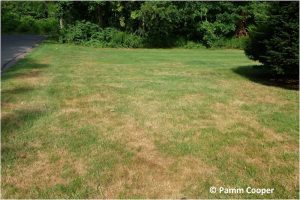 Clean up Gently
Clean up Gently
In the spring, remove any large debris from the lawn that may have the potential to smother and kill your grass as it starts to resume growth in the spring. Once excess debris is removed, rake your lawn to remove any dead grass.
Get Rid of Bare Spots
Reseed any bare patches with grass seed to reduce spaces where weeds can grow and help to create a dense and consistent turfgrass surface to match the rest of the lawn’s lush look.
Don’t Cut the Grass too Short
Mowing the lawn too short can cause it to “stress”, which in turn will prevent it from flourishing. The height of cut should be maintained at least 3 inches tall. Never remove more than 1/3 of the leaf blade during the mowing process. Grass clippings should be returned to the turfgrass surface. As the leaf clippings degrade, they release nutrients back into the turfgrass lawn.
Sharpen Mower Blades and Clean Up
Sharpen mower blades and clean mowing equipment of debris. When cleaning off equipment, make sure that grass clipping stuck on the underside of the mower is not rinsed where they can get washed into stormwater drains.
Water (If needed)
During the growing season, consider watering lawn areas, if there have been no measurable rain. Lawns require about an inch of water/week, therefore deep and infrequent watering will keep the lawn healthy during the hot summer months. Water early in the morning to allow the turfgrass roots to absorb the water, but also time for the leaves to dry.
Lawns that are not irrigated will become dormant and “rest” during the hot summer months, but will resume active growth when hot summer temperatures turn cool.
Different turfgrasses require different watering or nutrients to persist. Consider turfgrasses that utilize less water or fertilizer in lawns with little activity. Some grasses are better suited to full sun, others better suited to partial shade. Fine fescues can survive with few inputs and do well in dry partial shade conditions.
Feed Your lawn
Like people, turfgrass lawns, require nutrients protect itself against insects, weeds or diseases that grow in the turfgrass canopy. Fertilize when turfgrass is actively growing so that the lawn will benefit from each fertilizer application.
Fertilizing your lawn is important, especially if the lawn may thin out due wear damage from active children and pets.
Fertilizers that release nutrients slowly over time (slow release) can extend the duration of feeding. Quick release fertilizers provide a quick response and do not provide a consistent slow release of nutrients. Slow release fertilizers can be synthetic or organic.
Older lawns typically require less fertilizer than younger lawns. Overtime older lawns can release nutrients back into the soil.
Attract Pollinators to your Garden
Pollinators will be attracted to all flowering plants, including weeds in the lawn. If pollinators are to be protected, mow the lawn to remove the flowers before any herbicide is applied. Pollinators will not travel to weeds to collect pollen if the flowers have been removed.
Clean and Polish
Make sure you have cleaned and lubricated all the garden tools you have been using before storing them away.
Give Your Lawn What It Wants
Fertilizing your lawn is absolutely necessary if you find that it is struggling to grow. Completing this process in the early spring will jumpstart the growth of your grass.
Hire the Professionals
Hire a professional landscape contractor or lawn care company to help manage your lawn. These professionals are trained to make environmentally friendly adjustments that will help you grow a healthy lawn.
Visit s.uconn.edu/fertadvisor for more tips on how to maintain the perfect yard.